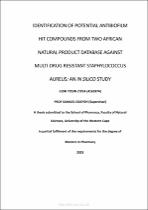| dc.contributor.advisor | Egieyeh, Samuel | |
| dc.contributor.author | Ilori, Tosin Lydia | |
| dc.date.accessioned | 2024-01-23T10:27:31Z | |
| dc.date.available | 2024-01-23T10:27:31Z | |
| dc.date.issued | 2023 | |
| dc.identifier.uri | http://hdl.handle.net/11394/10621 | |
| dc.description | Magister Pharmaceuticae - MPharm | en_US |
| dc.description.abstract | One of the crucial ways by which Staphylococcus aureus develops resistance to antibiotics is biofilm formation, a protective mechanism involving extracellular polymeric substance (EPS) matrix that shields microorganisms from the effects of antibiotics, mechanical forces, pH, and host immune responses. While some encouraging results point to the possible use of FDA-approved medications against biofilms, more research is needed due to sporadic and patchy data. The complex chemical diversity of natural compounds makes them a reservoir of bioactive molecules for drug discovery. This study seeks to identify effective potential antibiofilm compounds from a query dataset compiled from two African natural product databases (SANCDb and AfroDb). A database of known antibiofilm compounds was created from ChEMBL, PubChem, and other related databases while a query dataset of natural products was compiled for this study. The ligand similarity (LS) searches were unable to unequivocally identify distinct differences in the molecular structures and functional group moiety of the active and inactive compounds. | en_US |
| dc.language.iso | en | en_US |
| dc.publisher | University of the Western Cape | en_US |
| dc.subject | Biofilm-associated Proteins | en_US |
| dc.subject | COVID-19 | en_US |
| dc.subject | Deoxyribonucleic Acid | en_US |
| dc.subject | Antibiofilm | en_US |
| dc.subject | Biosurfactant | en_US |
| dc.title | Identification of potential antibiofilm hit compounds from two African natural product database against multi-drug resistant staphylococcus aureus: an in silico study | en_US |
| dc.type | Thesis | en_US |
| dc.rights.holder | University of the Western Cape | en_US |

